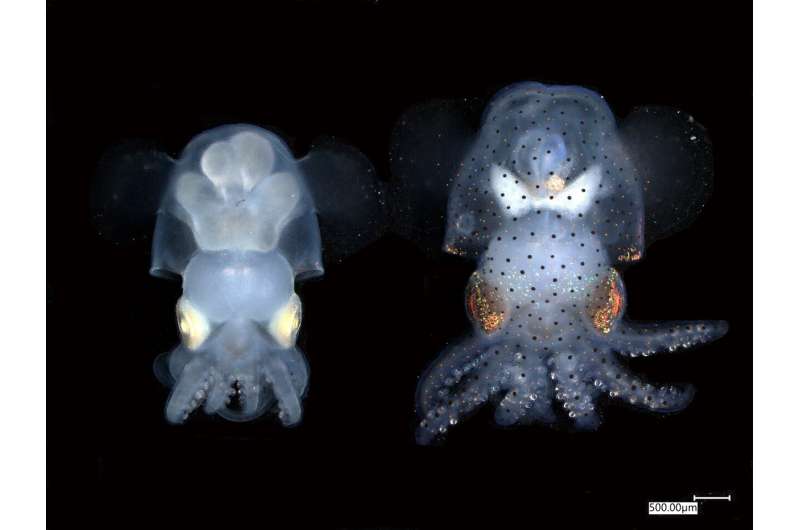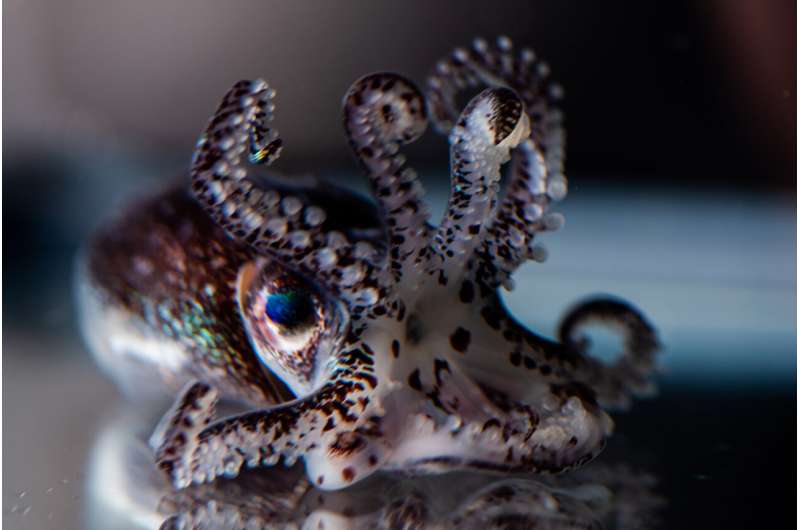This article has been reviewed according to Science X's editorial process and policies. Editors have highlighted the following attributes while ensuring the content's credibility:
fact-checked
peer-reviewed publication
trusted source
proofread
See-through squid lets scientists study cephalopod nervous system

A team at the Marine Biological Laboratory (MBL) has successfully engineered an albino strain of the hummingbird bobtail squid, Euprymna berryi. This advance, reported in Current Biology, has created a nearly transparent organism that offers scientists, for the first time, clear optical access for visualizing the nervous system in a living cephalopod.
It is also the first time a genetically engineered cephalopod has been bred through multiple generations, revealing E. berryi's great promise as a cephalopod model organism for neurobiological and other types of research.
"There's a whole lot of incredibly interesting biology surrounding cephalopods, unlike any other invertebrate," said MBL Senior Scientist Joshua Rosenthal, who co-led the study with MBL Hibbitt Fellow Caroline Albertin. "We now have a model cephalopod where we can interrogate biological function at much higher resolution than before."
The nervous system and behavior of coleoid cephalopods (squid, octopus and cuttlefish) are far more complex than most invertebrates. For one, they can learn and remember intricate tasks: cephalopods solve mazes, use tools, and even learn by watching others. They can instantaneously camouflage themselves, manipulate their surroundings with their arms and tentacles, and, according to a recent MBL study, acclimate to a colder environment by editing their own RNA to an enormous degree.
What cephalopod studies have lacked, however, is a model organism amenable to genetic study. While decades of research into fruit flies and mice has uncovered the genetic basis of development, behavior, and evolution in those animals, the lack of tools to investigate cephalopod biology has meant our understanding of these fascinating creatures is limited. This new study presents Euprymna berryi as a viable candidate for a model cephalopod: in addition to being easy to breed over generations in a lab, it can be genetically modified.
"The ability to directly and precisely test gene function in a model cephalopod is exciting because it makes it possible to study the features that make cephalopods special—and it will be an important tool for understanding many different aspects of their unique biology," said co-author Albertin.

The team established the albino lineage of E. berryi by deactivating the genes for two pigmentation enzymes using CRISPR-Cas9 genome editing. Then, co-authors Cris Niell at University of Oregon, Eugene, and Ivan Soltesz at Stanford University examined the albino squid's brain activity by inserting a fluorescent dye into its optic lobe.
This dye glows every time it detects calcium, which the brain releases when it fires. They then projected a series of images onto a screen in front of the squid, causing its optic lobe to activate and the dye to light up, all of which was captured using an imaging microscope. When the team tried the same technique with a wild-type squid, its skin pigmentation prevented them from seeing the dye clearly.
This discovery "allows us to look at gene function and cephalopod brains in ways we couldn't before," said Rosenthal. If other scientists want to understand how signals are relayed through cephalopod brains, they can now breed albino squid and do similar experiments with calcium-activated dye. Or, if a researcher wants to genetically alter these squid to study other aspects of their biology, the team's research demonstrates that such experiments are possible.
In this study, Rosenthal and Albertin's team discovered a new facet of E. berryi's biology. When the team deactivated the first pigmentation gene, called TDO, they expected to produce an albino squid, as they had done with another species of squid (Doryteuthis) in a 2020 study. The resulting E. berryi offspring, however, were still pigmented. The team soon realized the pigment was also being generated by a second enzyme called IDO, a protein previously unknown in cephalopods. Why E. berryi has two enzymes that seem to perform the same function remains unknown.
Rosenthal, Albertin and colleagues hope other scientists decide to expand our understanding of E. berryi and use them to unlock some of the mysteries of cephalopod biology.
"We want to see these animals shared with the research community," Rosenthal said. "Cephalopods contain treasure troves of biological novelty. We want to see people using them to ask thought-provoking questions and come up with novel findings."
More information: Joshua J. C. Rosenthal, Creation of an albino squid line by CRISPR-Cas9 and its application for in vivo functional imaging of neural activity, Current Biology (2023). DOI: 10.1016/j.cub.2023.05.066. www.cell.com/current-biology/f … 0960-9822(23)00739-X
Journal information: Current Biology
Provided by Marine Biological Laboratory




















